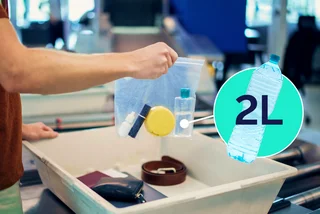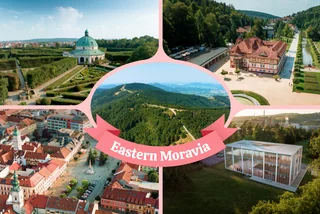Expats.cz is proud to introduce a new series of articles taking a look at Prague, district-by-district. Check back each month for a new article covering a different area of Prague.
KARLÍN (Prague 8)
The famous Czech singer Ivan Hlas has paid tribute to it. It was almost swept into history by the tempestuous floods of 2002, which made it famous for all the wrong reasons. But, as the campaign slogan goes, it “žije dál (lives on)”, and continues to rebrand itself as one of Prague´s most intriguing emerging neighborhoods. It is the district of Karlín.

Flooded Sokolovská Street in 2002
Location
Few Prague quarters are so neatly delineated on maps, either paper or mental, as Karlín. Prague 8, the borough of which the neighborhood forms the westernmost part, shares a border with the city center, and the borderline is the section of elevated highway at Florenc. Karlín´s eastern boundary is formed by the Invalidovna housing estate; the northern and southern edges are the River Vltava and Vítkov Hill, respectively. Karlín covers a rectangular area of roughly 80 hectares.
History
It´s hard to imagine that just two centuries ago vibrant streets such as Sokolovská were tranquil countryside and that the only significant building in the area was the imposing Baroque Invalidovna complex, modeled on Les Invalides in Paris. Karlín was the first part of Prague to spread beyond the old city walls, in the early 19th century. It developed as a gridiron of long low-rise residential streets intersected with narrower thoroughfares, parks and gardens.
In its early days, Karlín was a very pleasant place to live; later on, industries began to move in and wealthier residents moved out. The arrival of the railways further changed the character of the district, and over time, it acquired a reputation as one of Prague´s less salubrious quarters. Most of the building stock, some of it architecturally interesting, remained untouched for much of the 20th century but badly needed renewal. Communism froze Karlín in a grey and melancholy timewarp, and it continued to decline.
The changes of 1989 inevitably had a profound impact on Karlín, resulting in a fascinating juxtaposition of old and new that give it unique atmosphere even today. Its prime location near the center made it very attractive to real estate firms, who have invested huge sums in transforming the area. Robust and architecturally noteworthy old factories were eyed up by savvy developers: the transformation of the old ČKD Dukla plant into the Corso Karlín office block by renowned architect Ricardo Bofill is a symbol of the new, bright, sophisticated Karlín. Shabby but sound 19th century tenements and attractive Art Nouveau blocks are sought after by young professionals. Loft living rather than grime and grit are associated with the neighborhood, and several new office blocks have been built in the no-man´s land between Karlín and the River Vltava.

Ricardo Bofill’s Corso Karlín office block
The ongoing transformation suffered a huge setback when the floods of 2002 tore through the neighborhood and turned it upside down. Many locals lost everything, lives were ruined, and buildings collapsed or were condemned. Residents were evacuated, some never to return, and for months many parts of Karlín bore an eerie resemblance to a blitz-ravaged city. A complete absence of street lighting in the early aftermath turned Karlín into a black hole in the townscape at nightfall. Gradually, however, things began to improve, and although a slice of local life has disappeared for good and some buildings remain uninhabitable almost a decade on, Karlín has picked itself up. Evidence of this can be clearly seen in Sokolovská Street, the bustling main artery, which has an increasingly diverse range of shops, restaurants, and services.
Getting there and around
Karlín is one of Prague´s most accessible places to live and a very convenient destination for commuters travelling to the many offices within its boundaries. In addition, the entire neighborhood is within walking distance of the city center, especially the western section. Journey times between the downtown and Karlín by metro and tram should take no more than 10 minutes. Karlín can also be approached on foot from Žižkov via the tunnel under Vítkov Hill.
Karlín enjoys excellent public transport links, and as the neighborhood is crammed into a relatively narrow area, the main routes run on an east-west axis. The key corridors are Sokolovská Street, along which trams operate, parallel Křižíkova Street, and a metro line, much of which runs directly under Sokolovská Street. Florenc, Křižíkova and Invalidovna metro stations serve the district; the last two stations are on line B (Černý most to Zličín), which bisects line C (Letňany to Háje) at Florenc metro station, on the western edge of Karlín. The station is a key transport hub, and tram numbers 8 (Podbaba to Starý Hloubětín) and 24 (Kubánské námestí to Kobylisy) currently stop at the Sokolovská entrance. Prague´s main bus station is a minute´s walk away, and Masaryk train station (Masarykovo nádraží), while technically not in Karlín, is approximately 10 minutes walk from Florenc metro station. Prague´s main train station (Praha hlavní nádraží), from where international trains depart, is one stop away from Florenc station on metro line C. There are also good connections with the large stations at Holešovice (nádraží Holešovice) and Smíchov (nádraží Smíchov). Metro lines C and B respectively of Florenc metro station link it with these stations.
Environment
Karlín, like its counterparts Smíchov and Holešovice, was once associated with dirt, smoke, and a poor environment, and has seen huge environmental improvements and cleaner air. The floods of 2002 inevitably caused immense damage, although the public health issues arising from the flooding were soon resolved after it. The floods also helped speed up the general improvements in the area.
Although the air is relatively clear, pollution can still be a problem due to Karlín´s enclosed position in a valley. Other environmental issues are dog excrement, a perennial nuisance in Prague, and uncleared snow in winter, which is also a source of irritation throughout the capital. The first two months of 2010, in particular, highlighted the danger of untreated sidewalks, and the problem was exacerbated by a change in allocating responsibilities for removing snow from public spaces.

The church of Saints Cyril and Methodius in Karlín from the nearby hill of Vítkov
Green space
Despite its reputation as highly urban area, Karlín residents have plenty of access to green space: Karlinské náměstí is a small park, and towering over it is the long ridge of Vítkov Hill, well-known for its superb views over the city. The elongated summit is a favorite spot for strollers and inline skaters, who glide along the straight road running to the recently restored National Memorial, complete with newly-opened viewing platform. Next to it is the brilliantly situated equestrian statue of Hussite warrior Jan Žižka, which always looks ready to charge into streets below. The statue is reputedly the largest of its kind in the world and looks particularly impressive when it suddenly hoves into view from below. There is more military interest downhill (or uphill, depending how you approach) at the Army Museum, tucked into the lower slopes of Vítkov Hill.
Although Karlín is beside the Vltava, it is easy to forget the existence of it. The river does not really play a role in the neighborhood and although it is accessible in places, riverside walks and cycle routes are limited.

Former market at Karlínské náměstí
Housing
Karlín is one of the most homogeneous areas of Prague regarding housing stock and can be summed up in one word: tenements; those wishing to buy or rent a villa or any other form of housing are advised to direct their efforts elsewhere. The majority of apartments date from the 19th or early 20th century, although more recent housing stock occurs sporadically. Typically, blocks are grouped around a central courtyard, and some older buildings have preserved their external galleries, an attractive structural feature and social facility common in Prague in years gone by. Apart from the tenements that were condemned after the floods, most of the housing stock is in relatively good condition. The Art Nouveau tenements, particularly in the eastern sector, are of better quality: the streets around Lyčkovo náměstí resemble Vinohrady. Tenement living predominates in Karlín, though the housing stock is changing due to the reconstruction of the old factories as lofts as well as new build projects. Developer Real Estate Karlín has been actively involved in converting industrial space into living space, such as the Cornlofts project.

Cornlofts. Photo: Ondřej Polák
Prices of new build properties are in the range of CZK 4-7 million for a two-roomed apartment with kitchenette, CZK 6-10 million for a three-roomed apartment with kitchenette and CZK 8-11 million for a four-roomed apartment with kitchenette.
Housing experts point out that although Karlín lacks some of the advantages of Vinohrady, it has better house prices, is the same distance to the center and has very easy access to the office district adjacent to the Hilton Hotel. “Of course will become one of Prague´s important districts for expats soon,” says Petr Soukup of Prague-based estate agency Lexxus.
SUMMARY
Strengths
· Excellent location near the centre
· Excellent public transport links
· Access to Vítkov Hill
· Good location for professionals and couples without children
Weaknesses
· Pollution can be a problem
· Lack of off-street parking
· Lack of sports facilities
In the second part of this article, we will concentrate on other aspects of life in Karlín: shopping and services, restaurants, cultural opportunities, sports and leisure and facilities for families. We will also summarize the pros and cons of the area.
***
OTHER PRAGUE DISTRICTS:












 Reading time: 8 minutes
Reading time: 8 minutes 




















